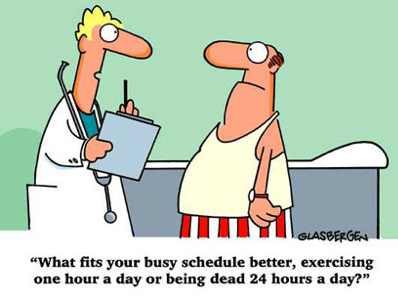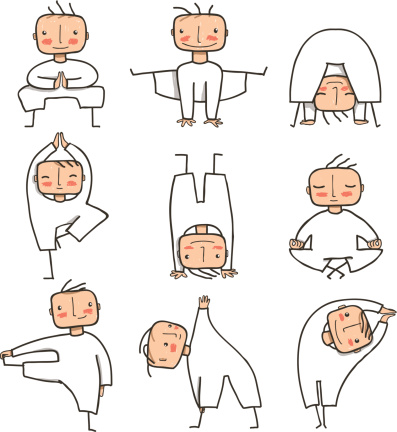Workout Trends
Workout Trends helps you DESIGN an action plan for your life, a program you can follow despite the demands of a BUSY lifestyle, the one that can get you RESULTS. Learn what WORKS and what DOESN'T for your fitness goals.
Read MoreHow To Survive And Stay Fit in the Night Shift Lifestyle
A few days ago when I shared one of my articles on ashtanga yoga on LinkedIn, and somebody commented:
Thanks for your tips on ashtanga yoga. I am a nurse and I work night shift. I am scared that my night shift exposes me to severe health risks. I wanted to start yoga but I am not sure how to fit “yoga” into my night shift lifestyle? Any advice?
 I have to admit, while working in a regular, normal shift (I mean, the morning shift), and enjoying my regular, normal yoga (again, morning yoga), it never occurred to me if those who worked in night shifts do yoga or not.
I have to admit, while working in a regular, normal shift (I mean, the morning shift), and enjoying my regular, normal yoga (again, morning yoga), it never occurred to me if those who worked in night shifts do yoga or not.
Or do they even want to?
From my understanding of yoga, I knew that the time of practice or your schedule did not really matter as long as you breathed right and took care of the alignments. But, one does need to take care of a few things.
This night schedule is upside down after all. And what does one usually get if they come to internet looking for tips? All information meant for day shift workers!
I was left aghast.
More than 15 million Americans work full time on evening shift, night shift, rotating shifts, or other employer arranged irregular schedules, exposing themselves to so many health risks.[1]
Now, after 15 days of hard work and research post that discussion, I’m equipped to answer all queries about keeping up with health while working in a graveyard shift.
- What makes night shifts or irregular shifts so dreaded? (Also, why do some people still love it?)
- Is there a way to ease such a lifestyle?
- Why is it essential for night or irregular shift workers to work out? (even more than their day shift counterparts)
- Why I think only yoga will serve them best?
And finally, there are all kinds of jobs in a night shift too – cops, call center executives, bartenders, nurses, which put unique demands on the person.
So, what style of yoga and what specific poses should one choose; to first, remain healthy, and second, excel at the job.
If you are running short on time, check out our quick infographic!

The Potential Health Risks For Shift Workers
The biggest problem with a graveyard shift is “Irregular Sleep Pattern” – not getting sufficient sleep, or sometimes, getting too much of it. And as we know, both are unhealthy.
The reason is our inability to sync our (night) work life with our (day-ly) routine. Irregular sleep cycles put pressure on our biological clock and therefore, on our health as well.
Short Term Health Risks for Shift Workers
1. Irritable Bowel Syndrome
Gastrointestinal symptoms (digestive system basically) like upset stomach, nausea, diarrhea, constipation, and heartburn, which are a common complaint of a night shift worker, come under the umbrella of Irritable Bowel Syndrome or IBS.
While an upset stomach can be attributed to an improper diet intake, the rest are due to participation in shift work, especially rotating shift work. And unlike my presumption, this development of IBS and abdominal pain is independent of sleep quality.[2]
What are your options?
The easiest solution (a promising one too) I found was Melatonin.
Yep! The hormone melatonin. Its therapeutic effect is independent of its effects on sleep, anxiety, or depression.[3] But how safe is it? To some extent. It is not a drug after all. Although overuse may cause side effects. So a brief course in melatonin is okay but, for long term, you really need to find a way to handle IBS naturally.[4]
Why not go for Yoga?
A study compared the benefits of yogic intervention with that of conventional medicine on IBS patients and found, that within two months of beginning with yoga and doing the standard 12 poses a day, they felt tremendous relief in the symptoms, pain and anxiety.[5]
A regular practice of 12 standard yoga poses (read the study for the poses) , that’s all it took them. Wow!
2. Increased risk of injuries and accidents
During my research, I also came across a hospital-based survey carried out on 635 Massachusetts nurses. It compared nurses who worked only day/evening shifts with those who rotated. This survey brought out an important facet of working in shifts – the increased risk of accidents and injuries.

Can you believe the rotators had twice the odds of nodding off while driving to or from work, and twice the odds of an accident or error related to sleepiness?[6] This increased risk is because of a disrupted sleep-wake cycle that gives rise to mental and physical fatigue, loss of focus and alertness with increase in stress.
What are your options?
When there is a job as significant as that of a nurse, one must not compromise. The only known way to minimize these problems is to improve shift systems with respect to these factors.[7] But are the concerned authorities this compassionate to implement?
Why not go for Yoga?
You need to take charge of your own safety and hence, try to find at least 30 minutes in a day for yoga. A simple program of yogic stretch and breathing exercises is not only easy to learn, but can be practiced even by the elderly. You must take inspiration from our 96 year old yogini, Phyllis Sues.
Even the simplest of yoga stretches have a markedly ‘invigorating’ effect on perceptions of both mental and physical energy and increase high positive mood.[8][9]
3. Insomnia (SWSD)
Like I told you, of the many health-related effects of shift work, disturbed sleep is the most common.[10] Insomnia or excessive sleepiness associated with shift working is so prevalent that its been given a medical term, Shift Work Sleep Disorder (SWSD).
From a 2004 study I gathered, that those who suffer from SWSD are more prone to ulcers, moodiness, absenteeism and depression. Imagine all that happening just because of sleep. But what surprised me more was the morbidity that came with SWSD. It was significantly greater than that experienced by day workers with identical symptoms.[11]
What are your options?
The only solution I could think of here is resetting the body clock as per the requirements of the work shift.
Shift work simulation studies and a few field studies indicate that daylight exposure in the early morning or bright lights can inhibit adaptive circadian phase resetting.[12]
This means wearing dark goggles while driving back home in morning, rushing to bed, and dozing off in a room devoid of light sources can actually help you out.
People whom I talked to while researching this piece, reported trying this technique. You can read their experiences later in this post. They found it effective to some extent but, telling mind to stop stressing out was a major pain.
Why not go for Yoga?
A research aimed at evaluating the effects of yoga on sleep during a 14-day practice, found a significant reduction in awakenings where subjects reported sleeping better and waking up fresh the day after.[13] I’m sure you can devote 14-days to sleep better everyday.
Read more on sleep: 1 Tip To Ditch Pills And Sleep Better Naturally
4. Decreased quality of life and a general feeling of being unwell
The above disruptions decrease the overall quality of life with less ‘quality’ time available for family and friends. There is chronic fatigue, reduced memory and attention span, and a persistent feeling of ‘shift-lag’. Leaving many of you feeling depressed and sick.
What are your options?
Become the President and get everyone to work graveyard shifts!
Oops, I forgot. Being President is even worse. Its a full time affair.
Why not go for Yoga?
Since no real external solution is present to your problem, as Buddha said, why not seek the answers within.
A lot of studies have been conducted in this regard, on chronically depressed patients. With most of them supporting yoga’s stand as a complementary treatment. They found a significant reduction in depression, anger, anxiety, neurotic symptoms and low frequency heart rate variability.[14][15]
Plus, it is cost-effective and easy to implement.
When it comes to the long term health issues (with long term I mean, more than 15 precious years of life given to working in irregular shift), the risks are even more dreadful. Not trying to scare you, but what you read henceforth could be your future. (Notice the stress on could be, because with one right move, you can change your future).
Long Term Health Risks for Shift Workers
1. Diabetes, Obesity, and Metabolic Syndrome
If the 2005 study on Japanese shift workers is to be believed, then you may be doubling your chances of getting Diabetes Mellitus while working in shifts for long term.[16] Apart from that, there is a significant exposure effect on BMI (Body Mass Index) too.[17]
In case you are wondering exposure effect on BMI is due to the normal advancement in age, well then, you are right.
But, you must also know that this increase in BMI is steeper for the day-night shift group than for the day shift group.[18] Not only that, obesity, high triglycerides, and low concentrations of HDL cholesterol seem to cluster together more often in shift workers than in day workers. Its a metabolic syndrome you see.[19]
Why not go for Yoga?
40 days into yoga and Type 2 DM patients reported 26% decrease in BMI and anxiety, 49% increase in feeling of general well being.[20][21]
In another humongous study, when 15,550 adults, aged 53 to 57 years, were surveyed on their health and physical activity (including yoga) during the past decade, out of all the physical activities yoga came across as a practice associated with attenuated weight gain (9.5 lbs versus 12.6 lbs). The results were even better among individuals who were overweight (-5.0 lbs versus 13.5 lbs).[22]
Even in general population, health indicators like fasting blood glucose, cholesterol ratio, and total triglycerides were significantly lower, with HDL being higher. The changes were markedly better in diabetic subjects.[23]
Would you be surprised if I told these results became visible only after a period of 9 days? 🙂
2. Depression and Mood Disorders
The little on and off scratch of depression you felt back then is now a full grown monster tearing your flesh off, and is called Major Depressive Disorder (MDD).
Yes, like your furniture, your home, your family, and everything else, depression has become a permanent part of your life too. Most of us continue to work in shifts without sparing a thought to the detrimental way it is affecting us.
When MDD population was studied in relation to long term (about 15-20 years) shift work, there was an unexpectedly high prevalence of MDD during and after shiftwork, with a higher rate for women than for men.[24]
Why not go for Yoga?
Here also there is research evidence and this time it is based on five randomized controlled trials located from major biomedical databases like MEDLINE, EMBASE, CiNAHL, PsycINFO and the Cochrane Library. To keep the judgement unbiased, the trials were chosen such that they utilized different forms of yoga interventions and severity of the condition ranged from mild to severe. Guess what the observations could be?
All trials reported positive findings![25]
I’ll give you a small (science-based) recipe:
Nine sessions, each of 90 minutes, comprising three different types of Iyengar Yoga poses: backbends, forward bends, and standing poses, and three repetitions of each type[26] – Your kick back to monstrous MDD.
For more, read: Choose Peace – 3 Facts on Mental Health that can change the way you deal with stress
3. Cancer
Studies do provide evidence that shift work may be associated with the risk of developing breast cancer, but nothing is sure yet.[27][28]
This has much to do with Melatonin. Remember the sleep-wake regulating hormone I told you about?! It also has another very important function – keeping a check on the proliferation of cancer (creating barriers to stop it from spreading to other organs). But there is a minor glitch here:
It is only produced in the dark.
Working in night shift exposes one to light more often, thus suppressing the natural production of melatonin. This low level may predispose these employees to develop cancer. On that basis some scientific evidences suggest that working a rotating night shift at least three nights per month for 15 or more years may increase the risk of colorectal and breast cancer in women.[29]
Also, the growing literature indicates that such women may benefit from cancer prevention strategies.[30][31] I solemnly agree that there is limited evidence, but one cannot risk his only life on a belief that they will never contract it.
Why not go for Yoga?
I once interviewed Kathryn Livingston, author of “Yin, Yang, Yogini”, where she writes about her life before and after breast cancer. She was healthy and happy, and the thought of having cancer in her body never crossed her mind.
Yet it reserved a place in there.
And yoga helped her get through it.
This might seem like a random story but scientific studies confirm yoga therapeutic role in treatment of breast cancer.
Not just rehabilitation, but prevention as well. Read this article here: Yoga for Breast Cancer – Study
4. Problems with Fertility and Pregnancy
There is a strong evidence against shift work which associates it with menstrual irregularities, reproductive disturbances, risk of adverse pregnancy outcome, and sleep disturbances in women. Out of all the nurses questioned, 53% of them reported noticing change in menstrual cycle as their shifts became irregular.[32]
The case is more serious for nurses and midwives. The observed negative influence on the fecundability (ability of women to become pregnant) crosses 80%.[33]
Why not go for Yoga?
The major reason for this is again the disturbed biological clock, due to which all hormonal systems go haywire. This increases stress levels as well which further elevate the magnitude of the problem.
Though Yoga does not boast of proven results, it still can help. It is known to influence positively in both female and male infertility cases by minimizing stress, balancing hormones of the body, and improving mental health; thereby increasing a couple’s ability to conceive.[34][35]
Apart from these shift work has also been linked to cardiovascular disorders.[36]
So, should you ‘quit’ your Shift job?
 I asked a lot of people, also found an article on The Guardian in this regard. Frankly, I was stunned that people actually loved working in a night shift.
I asked a lot of people, also found an article on The Guardian in this regard. Frankly, I was stunned that people actually loved working in a night shift.
Among the people I inquired was Nick, author of “How to Succeed in Anesthesia School“. According to him, work environment is much less formal during night, with a friendlier staff, and a laid back attitude.
It’s easier to schedule breaks and get other things done during work hours. Plus, there is NO management at night.
Diana Piper, a designer at Borsabag is no different. She recounts her first job, a third shift at IBM distribution centre below:
“My work week was Sunday through Thursday, 11:00 p.m. to 7:00 a.m. On the weekend I would arrive home Friday morning and stay awake until about 9 p.m. By then I was so tired I could hardly climb the stairs to go to bed. I would sleep Friday and Saturday night and stay awake all day Sunday, leaving for work about 10 p.m.
By Monday morning, I was exhausted and eager to get some sleep. My weekday would begin about four p.m. I would get up, shower and dress, and then prepare dinner for my family. Initially it was a tricky adjustment, creating and eating a full dinner first thing in my morning; but eventually, I got used to it, and I could actually enjoy eating dinner to start my day.”
From other numerous responses I received, I realized that it is not a night shift job that is an issue, its basically the irregular shifts that creates menace. So, no matter how much you love your job, you still are exposing yourself to a lot of medical issues.
I wouldn’t say that yoga can completely reset your ‘circadian rhythm’ (the fancy name of biological clock) or reverse the damage entirely. But, it sure can help you get a better sleep, calm your hormones and mood swings, and take care of your digestion and metabolism.
In short, it can compensate for the damage done by working in night shifts.
How to begin with Yoga?
Best time to get into a yoga pose
Since most yoga classes are held early morning, it is better to go for a yoga workout after your shift gets over. You’ll meet a new enthusiastic and supportive bunch of people. Your day will end with yoga while the rest will begin with it.
If you feel that it is exhausting, then, consider the case of day shift workers working out at night after office. If they can manage, so can you. Alternately, one can practice yoga before their shift begins. This is same as beginning the day with an energizing exercise. Much better than having a coffee or red bull to keep you awake.
Let me again clarify here, that your shift or time of day you choose for working out hardly matters. This stems from the assumption that you do not work out at all. And don’t we all agree that something is always better than nothing?
You can even workout during your shift.
Chair yoga is a wonderful option. I do it whenever I feel stress cloaking up my body. And since the work environment in night shift is much relaxed with co-workers open to new ideas, getting them to agree for two mini sessions of yoga (15 minutes each) is not tough. Begin by cutting short the loo and water cooler breaks and investing the saved minutes in keeping your body fit.
If you are worried about what your co-workers might think of you, well then, chuck all those thoughts, because they are going to appreciate your concern and will happily join you.
A tip for desk jockeys: For about 30 minutes a day, swap your regular chair with a stability ball. Not only you’ll be teaching your mind a better sense of balance that’ll come handy during old age, you’ll also be working on your core (abdominal) muscles. If you feel you are in a dying need to work on your flab, then this might kick start your effortless workout routine.
Finally, the best time to workout depends largely on personal preference. My suggestion is to try all the above mentioned timings for at least a week – before, after, and during the shift. Analyze what best fits your schedule and body clock, then follow it as and when you can.
Every stretch goes a long way.
Finding a style that works for me best
For knowing your options, you can read this article: 20 Tips To Pick And Practice The Perfect Yoga For You, which lists the most popular styles, its benefits, difficulty level, and who is it best suited for.
Night shift has as many jobs as the day shift, and some are even more challenging, mainly because of the absence of natural light. So, when job demands are different, the appropriate yoga needs to be different too.
For example, jobs like administrative officers, call centre executives, and that of transportation workers require long sitting hours without compromising in consistency of output, mental clarity and ability to focus. But, do things go as expected?
No.
Employees are often seen dozing off at the work table or while driving back home, which explains the number of accidents that occur in morning hours. Hence, a regular workout which can de-stress their minds, boost alertness, and re-align posture becomes a necessity. Such workers need to constantly stimulate their minds with a variety of poses and styles.
And did you know that organizing yoga for employees can help company profit in the long run? Do share this infographic with your authorities.
Along with that, employees should also engage in some cardiovascular activity to reduces chances of deep vein thrombosis (blockage in veins of legs due to long seated hours and lower body inactivity).
Psst……I’m working on designing a minimalist workout plan for each of the lifestyles mentioned here, so you don’t have to boggle your mind reading everything on the internet. Just follow our updates or tag me in a tweet, and I’ll mail you the corresponding yoga schedule.
Coming back to the lifestyle challenges, I feel that Nurses also fall in the above category, with the sole difference of being more physically active. While they might be able to save themselves from deep vein thrombosis, they still are at risk to developing various postural problems and constant body aches.
Hence, they need to work on their arm strength and keep a neutral back and shoulders while lifting things or patients. Not only that, they also should participate in a great deal of rotational exercise such as torso twists, which can provide them with enough mobility to pull an all nighter.
Minimalist Workout for a Night Shift Nurse
High stress coupled with high action jobs like that of cops often comes at a price persistent joint and back issues, postural problems, achy feet and knees. What they need are poses that avert all such dangers in future, while maintaining a sound strong body in present. Apart from yoga, they must incorporate weight training and activities like swimming and deep stretching in their daily routine.
Yoga with weights is a good option here.
Minimalist Workout for Police Officers
Similar is the work of bartenders. They do not require as much body strength as the cops do, but are required to stay focused and cheerful all night long.
Have you ever seen a hot headed nasty bartender? No, right?!
Because its their job to maintain calm at the most awful of the situations. Hence, mental relaxation is a major priority. Meditation and deep breathing techniques of pranayama, are what they should go for besides some stretching and strengthening yoga poses.
And finally the toughest, yet often ignored is the job of Firefighters. I have very deep respect for them. Their work calls for repetitive lifting, twisting, bending, sometimes frantic climbing up and down the stairs, and an exceptional ability to breathe and remain focused even when suffocated.
For such a demanding and significant role, physical fitness is paramount. And what’s better than yoga and its cousins – pranayama and meditation!
They make body flexible enough to reach cramped up spaces, enhance lung capacity, boost overall body strength, and is an incredible cardiovascular training. As an added bonus, they also improve mental focus and train the brain to remain during stress situations.
Once again, watch out for our upcoming series on lifestyle challenges. It has tons of research. If you want us to cover your lifestyle earlier, ping us on Twitter!
Crash course on Biological clock
If you thought your eyes were meant only to see the world or to convey emotions silently, you might have been walking around with only a half of the story.
The other half is eyes’ power to regulate our internal systems. Don’t give me that look. I know what I’m saying.
The light that gets in our eyes while they are open is primarily for viewing things around us. But, when they are closed (and even open), the light that escapes in through the eyelids is used to synchronize our day-night cycle, the sleep-wake cycle.
And every other system that falls in that loop including the hormonal and digestive systems.
Ever wondered how a rooster gets up earliest and hits hay earliest too?
Because their eyes (retinas specifically) are most sensitive to light. Anyway, why I’m telling you all this is not to make you change your schedule or body clock. But, to emphasize that you can actually do this, and you should.
Also, I bear an understanding that not everyone has an option to choose the shift they want to work in. So, here are a few things that you can do to get your peace back by re-syncing this clock according to your lifestyle needs. Did I tell you the techniques are all researched by the best scientists of the world?[37]
1. Light Therapy – Paying attention to light
Think of the biological clock like a pacemaker for brain regulating circadian rhythm (Circadian means, about a day). It is more or less 24 hours for everyone. One of the best ways to reset this clock is by paying attention to light and how it affects your brain. In simplest of terms, it makes your desire to sleep strongest between midnight and dawn.
There is a study to support this: When a group of people were asked to try to stay awake for 24 hours, many slipped into naps despite their best efforts. These unplanned nap times peaked between 2 a.m. & 4 a.m. and between 2 p.m. & 3 p.m.
The Technique
 Since, our circadian rhythm uses presence and absence of light to determine where we are in the 24 hour cycle of our day, Light therapy mimics this pattern. You expose yourself to bright lights for a specified amount of time upon waking and avoid it before falling sleeping. Over several weeks, (yes, you’ll need to give it some time) your body will adjust to the new rhythm. Didn’t I already suggest wearing dark goggles while going back home?
Since, our circadian rhythm uses presence and absence of light to determine where we are in the 24 hour cycle of our day, Light therapy mimics this pattern. You expose yourself to bright lights for a specified amount of time upon waking and avoid it before falling sleeping. Over several weeks, (yes, you’ll need to give it some time) your body will adjust to the new rhythm. Didn’t I already suggest wearing dark goggles while going back home?
You can learn a lot from Nick’s trials about this,
“Despite the advantages of a night shift, it’s important to stay healthy. Eating meals at the same times daily, wearing sunglasses on my way home in the morning, and sleeping in a dark room without interruptions during the day are three of the methods that helped me to work night shifts.”
2. Chronotherapy – Making time work for you
Its been my personal observation that its easier to stay up late and study, rather than wake up early and then study. Actually, the problem is not studying but waking up, inspite of being a morning person. Don’t you think its easier to shift time forward rather than trying to wind it back?!
If you do, then chances are Chronotherapy will work for you.
The Technique
The trick is not to force yourself to go to bed earlier in order to get back on a regular schedule. Instead, shift your bedtime later each night. Again, it will cost you several days, even weeks to ease into the night shift schedule. But the fruit of consistent effort will be very sweet. Promise!
3. Food exercise – Un-feed your clock
You are already aware of the fact that biological clock also governs our digestive system. This means, the amount of light entering our eyes decides the time of activation of our hunger pangs. And here I believed that its only the smell or sight of food that could wake up the ever hungry burger-loving elephants in my belly.
A Harvard Med School research pointed out that food can serve as a secondary mechanism to clock our bodily functions as part of our overall circadian rhythm. Thus, deciding when we feel hungry.
But how can I use this info?
The Technique
The research findings are still in the nascent stage but you can try it out and see if it works for you.[38] To reset your circadian rhythm avoid eating for 12-16 hours. This will supposedly bypass the normal triggers, giving you a new “morning”. Follow it with a healthy meal right after waking which will lead it to believe that that time is morning.
Closing thoughts
The bottom line is that we need to learn to move on, evolve, and make things work for us. Even if a night shift pays your bills, you can not let it take control of your health.
Being a devout yoga fan, I tried to make a case for it. But, it is not the only alternative. You can go for a regular gym workout or other physical activities like swimming, running, dancing, pilates, etc as well.
Additionally, whenever you get time off work or on a holiday, make sure that you:
1. Eat Well
2. Spend Time With Your Family
3. Exercise
What I intend to convey is – Stay active, Stay alert. And don’t let anything, even your job, ruin your future happiness or health.
Choose your priorities wisely.
 Useful resources:
Useful resources:
1. Optimal Shift Duration and Sequence: Recommended Approach for Short-Term Emergency Response Activations for Public Health and Emergency Management. doi: 10.2105/AJPH.2005.078782.
2. Yoga for anxiety and depression – Harvard Med School
3. Health for Shift Workers – The Athletic Club (pdf)
4. American Academy of Sleep Medicine: “Circadian Rhythm Sleep Disorders.” (pdf)
5. Night work throws body into chaos – BBC News
References [1] Work schedules, shift work and long work hours - CDC. ^Back to Top^ [2] Nojkov, B., Rubenstein, J., Chey, W., & Hoogerwerf, W. (2010). The Impact of Rotating Shift Work on the Prevalence of Irritable Bowel Syndrome in Nurses The American Journal of Gastroenterology, 105 (4), 842-847 DOI: 10.1038/ajg.2010.48 (full text). ^Back to Top^ [3] LU, W., GWEE, K., MOOCHHALLA, S., & HO, K. (2005). Melatonin improves bowel symptoms in female patients with irritable bowel syndrome: a double-blind placebo-controlled study Alimentary Pharmacology and Therapeutics, 22 (10), 927-934 DOI: 10.1111/j.1365-2036.2005.02673.x PubMed PMID:16268966. (full text). ^Back to Top^ [4] Melatonin is not a magic bullet for sleep -PsychologyToday.com. ^Back to Top^ [5] Taneja I, Deepak KK, Poojary G, Acharya IN, Pandey RM, & Sharma MP (2004). Yogic versus conventional treatment in diarrhea-predominant irritable bowel syndrome: a randomized control study. Applied psychophysiology and biofeedback, 29 (1), 19-33 PMID: 15077462. ^Back to Top^ [6] Gold DR, Rogacz S, Bock N, Tosteson TD, Baum TM, Speizer FE, Czeisler CA. Rotating shift work, sleep, and accidents related to sleepiness in hospital nurses. Am J Public Health. 1992 Jul;82(7):1011-4. PubMed PMID:1609900; PubMed Central PMCID: PMC1694075. (pdf). ^Back to Top^ [7] Folkard S, Tucker P. Shift work, safety and productivity. Occup Med (Lond). 2003 Mar;53(2):95-101. Review. PubMed PMID: 12637593. (pdf). ^Back to Top^ [8] Wood C. Mood change and perceptions of vitality: a comparison of the effects of relaxation, visualization and yoga. J R Soc Med. 1993 May;86(5):254-8. PubMed PMID: 8505745; PubMed Central PMCID:PMC1293998. (pdf). ^Back to Top^ [9] Appelle S, Oswald LE. Simple reaction time as a function of alertness and prior mental activity. Percept Mot Skills. 1974 Jun;38(3):1263-8. PubMed PMID: 4421761. (pdf). ^Back to Top^ [10] Akerstedt T. Shift work and disturbed sleep/wakefulness. Occup Med (Lond). 2003 Mar;53(2):89-94. Review. PubMed PMID:12637592. (full text). ^Back to Top^ [11] Drake CL, Roehrs T, Richardson G, Walsh JK, Roth T. Shift work sleep disorder: prevalence and consequences beyond that of symptomatic day workers. Sleep. 2004 Dec 15;27(8):1453-62. PubMed PMID:15683134. (pdf). ^Back to Top^ [12] Eastman CI, Stewart KT, Mahoney MP, Liu L, Fogg LF. Dark goggles and bright light improve circadian rhythm adaptation to night-shift work. Sleep. 1994 Sep;17(6):535-43. PubMed PMID:7809567. ^Back to Top^ [13] Kudesia RS, Bianchi MT. Decreased nocturnal awakenings in young adults performing bikram yoga: a low-constraint home sleep monitoring study. ISRN Neurol. 2012;2012:153745. doi: 10.5402/2012/153745. Epub 2012 Apr 12. PubMed PMID:22577578; PubMed Central PMCID: PMC3345216. ^Back to Top^ [14] Testa MA, Simonson DC. Assessment of quality-of-life outcomes. N Engl J Med. 1996 Mar 28;334(13):835-40. PubMed PMID: 8596551. DOI: 10.1056/NEJM199603283341306. (researchgate.net). ^Back to Top^ [15] Shapiro D, Cook IA, Davydov DM, Ottaviani C, Leuchter AF, Abrams M. Yoga as a complementary treatment of depression: effects of traits and moods on treatment outcome. Evid Based Complement Alternat Med. 2007 Dec;4(4):493-502. doi: 10.1093/ecam/nel114. PubMed PMID: 18227917; PubMed Central PMCID:PMC2176141. ^Back to Top^ [16] Morikawa, Y. Scandinavian Journal of Work and Environmental Health, 2005; vol 31: pp 179-183. (Morikawa Y, Nakagawa H, Miura K, Soyama Y, Ishizaki M, Kido T, Naruse Y, Suwazono Y, Nogawa K. Shift work and the risk of diabetes mellitus among Japanese male factory workers. Scand J Work Environ Health. 2005 Jun;31(3):179-83. PubMed PMID:15999569.). ^Back to Top^ [17] Monk TH, Buysse DJ. Exposure to shift work as a risk factor for diabetes. J Biol Rhythms. 2013 Oct;28(5):356-9. doi: 10.1177/0748730413506557. PubMed PMID: 24132061; PubMed Central PMCID: PMC4001827. ^Back to Top^ [18] Parkes KR. Shift work and age as interactive predictors of body mass index among offshore workers. Scand J Work Environ Health. 2002 Feb;28(1):64-71. PubMed PMID:11871855. ^Back to Top^ [19] Karlsson B, Knutsson A, Lindahl B. Is there an association between shift work and having a metabolic syndrome? Results from a population based study of 27,485 people. Occup Environ Med. 2001 Nov;58(11):747-52. PubMed PMID:11600731; PubMed Central PMCID: PMC1740071. ^Back to Top^ [20] Kosuri M, Sridhar GR. Yoga practice in diabetes improves physical and psychological outcomes. Metab Syndr Relat Disord. 2009 Dec;7(6):515-7. doi: 10.1089/met.2009.0011. PubMed PMID:19900155. ^Back to Top^ [21] Jain SC, Uppal A, Bhatnagar SO, Talukdar B. A study of response pattern of non-insulin dependent diabetics to yoga therapy. Diabetes Res Clin Pract. 1993 Jan;19(1):69-74. PubMed PMID:8472621. ^Back to Top^ [22] Kristal AR, Littman AJ, Benitez D, White E. Yoga practice is associated with attenuated weight gain in healthy, middle-aged men and women. Altern Ther Health Med. 2005 Jul-Aug;11(4):28-33. PubMed PMID:16053119. (pdf). ^Back to Top^ [23] Bijlani RL, Vempati RP, Yadav RK, Ray RB, Gupta V, Sharma R, Mehta N, Mahapatra SC. A brief but comprehensive lifestyle education program based on yoga reduces risk factors for cardiovascular disease and diabetes mellitus. J Altern Complement Med. 2005 Apr;11(2):267-74. PubMed PMID:15865492. ^Back to Top^ [24] Scott AJ, Monk TH, Brink LL. Shiftwork as a Risk Factor for Depression: A Pilot Study. Int J Occup Environ Health. 1997 Jul;3(Supplement 2):S2-S9. PubMed PMID:9891131. ^Back to Top^ [25] Pilkington K, Kirkwood G, Rampes H, Richardson J. Yoga for depression: the research evidence. J Affect Disord. 2005 Dec;89(1-3):13-24. Epub 2005 Sep 26. Review. PubMed PMID:16185770. (pdf). ^Back to Top^ [26] David Shapiro, Karen Cline. Mood Changes Associated with lyengar Yoga Practices: A Pilot Study. International Journal of Yoga Therapy — No. 14 (2004). (pdf). ^Back to Top^ [27] Davis S, Mirick DK, Stevens RG. Night shift work, light at night, and risk of breast cancer. J Natl Cancer Inst. 2001 Oct 17;93(20):1557-62. PubMed PMID: 11604479. ^Back to Top^ [28] Megdal SP, Kroenke CH, Laden F, Pukkala E, Schernhammer ES. Night work and breast cancer risk: a systematic review and meta-analysis. Eur J Cancer. 2005 Sep;41(13):2023-32. Review. PubMed PMID:16084719. ^Back to Top^ [29] Schernhammer ES, Laden F, Speizer FE, Willett WC, Hunter DJ, Kawachi I, Fuchs CS, Colditz GA. Night-shift work and risk of colorectal cancer in the nurses' health study. J Natl Cancer Inst. 2003 Jun 4;95(11):825-8. PubMed PMID:12783938. (full text). ^Back to Top^ [30] Viswanathan AN, Hankinson SE, Schernhammer ES. Night shift work and the risk of endometrial cancer. Cancer Res. 2007 Nov 1;67(21):10618-22. PubMed PMID: 17975006. (full text). ^Back to Top^ [31] Kolstad HA. Nightshift work and risk of breast cancer and other cancers--a critical review of the epidemiologic evidence. Scand J Work Environ Health. 2008 Feb;34(1):5-22. Review. PubMed PMID:18427694. ^Back to Top^ [32] Labyak S, Lava S, Turek F, Zee P. Effects of shiftwork on sleep and menstrual function in nurses. Health Care Women Int. 2002 Sep-Nov;23(6-7):703-14. PubMed PMID:12418990. ^Back to Top^ [33] Ahlborg G Jr, Axelsson G, Bodin L. Shift work, nitrous oxide exposure and subfertility among Swedish midwives. Int J Epidemiol. 1996 Aug;25(4):783-90. PubMed PMID:8921457. (full text). ^Back to Top^ [34] Sengupta P. Challenge of infertility: How protective the yoga therapy is? Anc Sci Life. 2012 Jul;32(1):61-2. doi: 10.4103/0257-7941.113796. PubMed PMID: 23929997; PubMed Central PMCID:PMC3733210. ^Back to Top^ [35] Khalsa HK. Yoga: an adjunct to infertility treatment. Fertil Steril. 2003 Oct;80 Suppl 4:46-51. PubMed PMID:14568288. ^Back to Top^ [36] Shift work and vascular events: systematic review and meta-analysis. doi: http://dx.doi.org/10.1136/bmj.e4800. ^Back to Top^ [37] Reset your brain for better sleep - Harvard Medical School. ^Back to Top^ [38] Study identifies food-related clock in the brain. - Harvard Gazette. ^Back to Top^











Christine
This is fantastic! Thank you for such great research. I worked nights for four years as a new nurse and loved it but definitely experienced many of the issues you discussed. While “off” shifts are so improtant and necessary in many professions, those who work these hours need to be diligent in caring for themselves.
Anant Mendiratta
Thanks, christine. If you liked this, the you should like this too: https://workouttrends.com/nurse-night-shift-burnout
Let me know your thoughts on this one 🙂
Erica Simson
Dhanurasana is the best yoga poses for night shift employees who want to reduce belly fat.